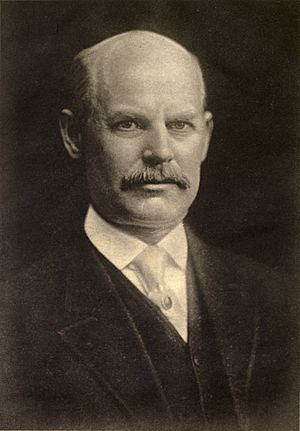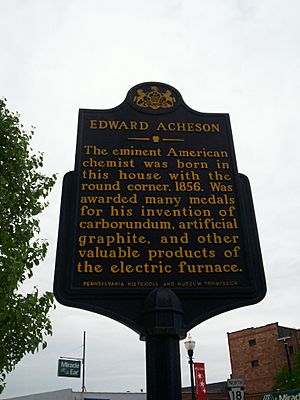Edward Goodrich Acheson facts for kids
Quick facts for kids
Edward G. Acheson
|
|
|---|---|
 |
|
| Born | March 9, 1856 |
| Died | July 6, 1931 (aged 75) New York City, USA
|
| Nationality | American |
| Known for | silicon carbide |
| Awards | John Scott Medal (1894) John Scott Medal (1901) Perkin Medal (1910) Edward Goodrich Acheson Award (1929) |
Edward Goodrich Acheson (born March 9, 1856 – died July 6, 1931) was a clever American chemist and inventor. He was born in Washington, Pennsylvania. Acheson created the "Acheson process," a special way to make important materials like silicon carbide (also called carborundum) and graphite. These materials are still used today!
Contents
Edward Acheson's Early Life and Work

Edward Acheson grew up in the coal mining areas of southwestern Pennsylvania. He went to the Bellefonte Academy for three years, from 1870 to 1872. This was all the formal schooling he ever had.
When he was 16, his father passed away. Edward left school to help support his family. He worked as an assistant for a surveying team with the Pittsburgh Southern Railroad.
Evenings were spent on his own science projects, mostly experiments with electricity. In 1880, he bravely tried to sell a battery he invented to the famous inventor Thomas Edison. Instead of buying his battery, Edison hired him! Edward started working for Edison on September 12, 1880, at his laboratory in Menlo Park, New Jersey. Edison asked him to find a way to make a special type of carbon that could conduct electricity. This carbon was needed for Edison's electric light bulbs.
In 1881, Edward Acheson traveled to Paris for the International Exposition of Electricity. He was part of a team led by Charles Batchelor. He stayed in Europe in 1882 to set up demonstrations of Edison's new electrical lighting system. He installed lights in places like the Antwerp City Hall in Belgium and the famous La Scala opera house in Milan, Italy.
Discovering Carborundum and Graphite
In 1884, Acheson left Edison's company. He became a supervisor at a factory that made electric lamps, which was a competing company. He started working on new ways to create artificial diamonds using an electric furnace.
He tried heating a mix of clay and coke in an iron bowl. He used a carbon arc light, which creates a very hot electric spark. After heating, he found shiny, six-sided crystals stuck to the carbon electrode. These crystals were silicon carbide, and he named them carborundum.
In 1891, Acheson built his own electricity plant in Port Huron, following an idea from Edison. He used the electricity from this plant to do more experiments with carborundum.
On February 28, 1893, he received a patent for carborundum, which was a very effective material for grinding and polishing (called an abrasive). He later received 70 patents for his inventions. These patents were for abrasives, graphite products, ways to reduce oxides, and special heat-resistant materials.
Edward Acheson passed away on July 6, 1931, in New York City.
Honors and Awards
Edward Acheson received many awards for his important work. In 1931, he was given the first Edward Goodrich Acheson Award, which was named in his honor by The Electrochemical Society.
In 1953, the Pennsylvania Historical and Museum Commission placed a historical marker outside his home. This marker points out the important things he achieved. In 1997, Acheson was added to the National Inventors Hall of Fame. His house, the Edward G. Acheson House in Monongahela, Pennsylvania, is now a National Historic Landmark.
The Electrochemical Society gives out the Acheson Award every two years. It honors people who have made great contributions to science and technology, just like Edward Acheson did.
See also
 In Spanish: Edward Goodrich Acheson para niños
In Spanish: Edward Goodrich Acheson para niños


